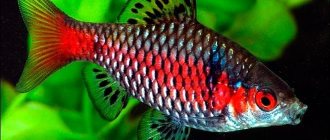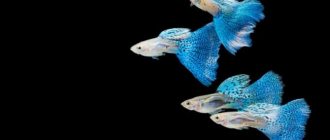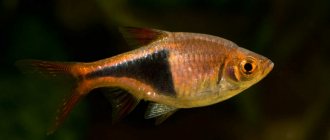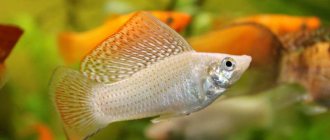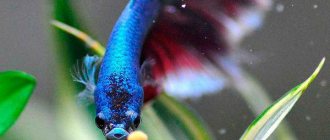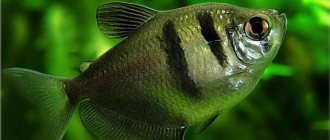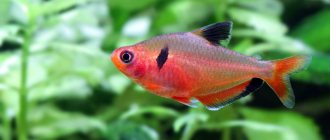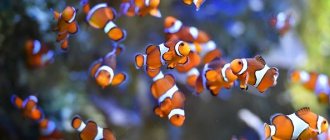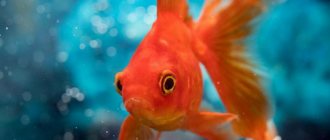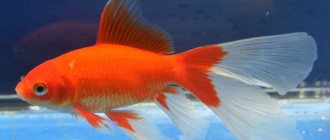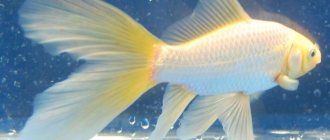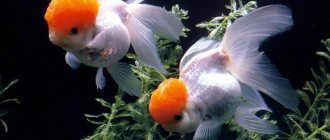Microrasbora galaxy has recently settled in aquariums. This beautiful and unusual fish attracts the attention of many aquarists. There was confusion with the name of this species; the species could not be assigned to one of the groups. The origin of the name microrasbora occurred during the classification of the type of galaxies as rasboras. But later it turned out that the galaxy is closer to omnivorous zebrafish than to rasboras. Therefore, another name is Danio margaritatus, and they were originally called Celestichthys margaritatus.
In the wild, the galaxy fish is found in the Nam Lan and Nam Paun rivers. When living in nature, they prefer water bodies overgrown with algae and pierced by the sun.
Description
Cyprinids of the galaxy are small freshwater fish from the Carp family and the Danio genus. The natural habitat is high mountain rivers and creeks.
The description of galaxies began only in 2006, when this species was discovered.
Appearance
The microrasbora fish does not reach a size larger than 2.5 cm. The body color is gray-blue. The color includes spots on the sides of the fish, resembling small pale yellow pearls. The fins, except the pectoral ones, are brightly colored. Red and black fins give the fish a provocative appearance. This is especially noticeable in dominant males. They even have a red belly. In females the color is dull and weak.
View this post on Instagram
The emerald microrasbora is a shy, but very beautiful fish, which is not very common among aquarists. #rasbora #microrasbora #microrasboraemerald #rasboraemerald #beautifulfish #fish #aquarium #aquariumism #underwaterworld #freshwateraquarium
A post shared by Evgeniy Aquariumist (@aqua.fish.club) on Jul 27, 2016 at 10:40pm PDT
Behavior
Microrasboras are peaceful, non-aggressive and very shy fish. Therefore, they get along calmly with other species that do not show aggression towards them. Well kept in the same aquarium with neutral and indifferent fish.
Male galaxy fish, when kept together, fight for females and territory. Fights take place without any serious injuries, but sometimes dominant individuals inflict serious damage on others.
Lifespan
The lifespan of galaxies is 3 years, but some centenarians live up to 5 years.
Interesting Facts
The Rasbora galaxy is protected by many states as an endangered species.
Here are some more interesting facts about this amazing fish:
- In Myanmar, the microrasbora galaxy is listed in the Red Book as a rare species. This fish became a victim of human greed. After its discovery, a massive capture of individuals began for sale to pet stores and private breeders, as a result of which the species was on the verge of complete extinction.
- The fish received a scientific description only in 2007 from Dr. T.R. Roberts. And the species was discovered a year earlier - in 2006.
- Where the galaxy lives, the weather often changes from warm to cold. Such an atypical and harsh climate made microrasbora hardy and resistant to adverse conditions.
Content
It is not difficult to maintain a microrasbora galaxy; tanks of any size, both large and nano aquariums, are suitable for it. Galaxies should be kept in a flock of at least 20 individuals. In large volumes of water, the number reaches several hundred specimens. It also does well in the company of shrimp or a few snails.
Aquarium
Galaxies are not demanding on the volume of the aquarium; they can easily be kept in small and large aquariums. Make sure that there is more than a liter of water per individual. Then the fish will feel comfortable. It is important not to forget about arranging the spawning area.
Small tanks
In small tanks it is important to create the right conditions. Be sure to plant some greenery, but don’t get carried away. The ground level is more than 3–4 cm. To decorate the tank, use miniature elements. Provide a minimum number of males, otherwise fights cannot be avoided.
Large aquariums
In a large container, galaxies look especially beautiful against the backdrop of a large aquarium and greenery and immediately stand out. The aquarium will need a large number of plants and other coverings. Soil – 4–6 cm. The number of individuals can be increased.
Water parameters
The main water parameter that must be met is water purity. The fish are not so sensitive to other parameters, they are able to live and spawn under different conditions, and are not too picky about water temperature and hardness.
Average indicators for keeping fish:
- The temperature of the water environment is 18–27 degrees.
- Average water hardness (2–15).
- Water acidity – 7 pH.
Plants
Micro-growing plants need vegetation. These can be waterfloating plants or planted in the ground.
Plants that work well:
- Salvinia floating.
- Riccia floating.
- Vallisneria.
- Water cabomba.
- Anubias.
- Schisandra.
Priming
Any soil is suitable. This includes coarse sand, granite, small pebbles, and decorative soil mixtures. When choosing a dark soil, the color of the fish will stand out especially beautifully.
Equipment
Although in nature fish live in stagnant water and do not like strong currents, you will need aquarium equipment. These are aeration and filtration systems. The aerating device must be weak and not create currents. The filter will help keep the aquarium clean.
Lighting
Galaxies are not demanding about lighting, but they prefer weak and diffuse lighting rather than bright. Such lighting in their natural habitat.
What to feed Microrasbora Galaxy?
Microrasbora galaxia what to feed
In their natural habitat, microrasbora galaxies feed on various types of algae, insects and zooplankton. They are also known to feed on small invertebrates and worms. However, in an aquarium, these fish will easily eat high-quality dry food, small flakes and pellets. If the fish are scared, they will keep the lower level in the aquarium; in such cases, sinking granules will come to the rescue.
Feeding any aquarium fish should be correct: balanced, varied. This fundamental rule is the key to the successful keeping of any fish, be it guppies or astronotuses.
We recommend taking food from the Tetra MicroFood series for micro-dispersal, namely chips. In our opinion, this is the ideal food for these speedy babies. The chips are small and sink very slowly into the water. Due to this, the fish have time to eat everything and fill their bellies to the top.
It should be noted that when purchasing any dry food, you should pay attention to the date of its manufacture and shelf life, try not to buy food in bulk, and also store the food in a closed state - this will help to avoid the development of pathogenic flora in it.
Feeding
Fish are not picky about their diet. Feed dry, frozen and live food.
In nature it feeds on small insects. They are also fed at home.
Insects to feed:
- Tubifex.
- Artemia.
- Bloodworm.
- Koretra.
It is important to give not only protein foods, but also to alternate proteins with plant foods.
The food is crushed because the fish will not swallow large particles.
During the first time in a new aquarium, they are fed only living creatures. Later the rest of the feed is introduced.
External characteristics
The tiny size of the fish - maximum 2 cm - is usually compensated by the number of individuals in the school and color. The body of the fish is standard for zebrafish - elongated, round, torpedo-shaped. The muzzle is smoothed, round black eyes have a silver-yellow edging. The main body color is greenish-brown. Yellow-pearl tiny spots are scattered across the entire surface like pearls: in the abdomen area there are more intense spots, towards the back there are slightly fewer spots. On the abdomen the spots merge into one large orange-pink one. The fins are small, translucent, with bright orange and pink stripes.
Compatibility
The aquarium fish galaxy feels good with peace-loving and neutral fish. Good neighbors will be:
- Angelfish.
- Microanalysis of the galaxy.
- Danio (margaritatus).
- Cockerels.
- Neons.
- Guppy.
- Gourami.
- Mollies.
- Catfish.
- Rainbows.
- Tetras.
- Sword bearers.
Average Compatibility:
- Acne.
- Shrimps.
- Crabs.
Completely incompatible with:
- Cichlids.
- Koi carps.
- Goldfish.
- Astronotuses.
Spreading
Microrasbora galaxy lives in northern Myanmar. In this southeastern country, the fish are called “celestial pearls.”
The habitat is high-mountain lakes with fresh water. Thanks to their unusual color, these fish have become popular in the aquarium hobby. Microsorts are considered exotic, which is why their price in pet stores is quite high.
[direct]
Reproduction
To propagate rasboras, you will need a separate container of 5–7 liters with plants. In the absence of vegetation, microbreeding will not work. From the flock, a bright male and a plump female with a rounded belly are selected. Increases the hardness and acidity of water by several units. Temperature – 20–22 degrees.
Males become even brighter than usual during spawning. They actively pursue the female. If there are other males in the container, they start fights. The winning male continues to chase the female, trying to drive her into the vegetation.
Sex differences
Galaxy fish have highly developed sexual dimorphism.
Females
The body is round and flattened. Females have a dull and dull color with pale spots. The genital papilla is black in color. Females are larger than males. The belly is round and convex
Males
They have a slender and elongated body with a slight curve in the back. Dominant males have bright colors. The sides are blue-green with contrasting light spots. The throat, belly and fins are red-orange. The abdomen is smooth and sunken.
Spawning
Once conquered, the female fish begin to spawn. They make a spawning ground in the leaves. Spawning occurs in several passes. During the week they spawn 2-3 times. The number of eggs ranges from 35 to 50 pieces. The larvae hatch after 3 days.
The parents protect the eggs and larvae and do not eat them. But the hatched fry can be mistaken for food.
Fry
After 2 days, the larvae form into fry and begin to feed. Feed ciliates. The aquarium temperature is 25 degrees. The fry live in the middle layers of water during the day, and at night they attach to the walls of the aquarium.
The fry have a strong immune system; they are not afraid of bacteria and viruses. Therefore, there is no need to maintain the aquarium sterile. They become similar to adults at 1-1.5 months, and sexually mature at 3 months.
Care of offspring
The ability of the fry to move and feed independently appears only after 5 days. Until this moment, they will be in a stationary position, attached to algae or the walls of the spawning area. Moreover, their size is no more than 2−5 mm.
There is no need for lighting or filtration; aeration can be set to minimum power.
The fry usually feed during the day and hide in algae at night. At this time, the fish can already be transplanted to the fry of other varieties of non-predatory fish. Feeding is initially done with rotifers or ciliates, after which you can gradually switch to brine shrimp.
The fry grow quite slowly. At the age of one and a half months, they can reach a size of 0.8-0.9 cm, and fully grow by 4 months. The color characteristic of adult fish will appear at 8-14 weeks.
Diseases
Infections
The infection enters the reservoir through low-quality feed, untreated soil and plants. Causes trichodinosis. Treated with antibiotics.
To avoid infection through purchased fish, do not forget about quarantine.
Obesity
With excessive and unbalanced feeding, fish develop obesity. Symptoms of the disease: the fish becomes fat, lethargic, and refuses to eat. For treatment, reduce the dose of food and balance your diet.
Bug-eyed
Poor water quality causes bulging eyes. During illness, the fish's eyes protrude and move out of the eye sockets. If left untreated, the fish goes blind and then dies.
Fungus
Fungus appears due to non-compliance with fish keeping standards, a dirty aquarium, or from other inhabitants. Fungal diseases often affect the outer shells of the body - scales, gills, fins. Treated with antibiotics and antifungal agents.
Interesting to know about galaxy microassembly
Microassembly galaxy interesting
On February 28, 2007, the Raffles Bulletin of Zoology published an article by T. Roberts, “The “Celestial Pearl Danio,” a new genus and species of colorful minute cyprinid fish from Myanmar (Pisces: Cypriniformes).” Roberts created a new genus for the fish, calling it Celestichthys (from the Latin caelestis - heavenly and Greek ichthys - fish). The specific name of the fish became margaritatus (from Latin - literally, decorated with pearls).
At the end of January 2008, in the pages of the scientific journal Zootaxa, I published an article by K. Conway, W. Chen and R. Mayden (Konway, KW, WJ. Chen & RL Mayden) “The “Celestial Pearl danio” is a miniature Danio (ss) (Ostariophysi: Cyprinidae): evidence from morphology and molecules,” in which the authors argue that the galaxy belongs to the genus Danio.
Today, the full scientific name of the fish is Danio margaritatus (Roberts, 2007).
Diseases microanalysis galaxy.
Oodiniosis is a disease caused by parasites that cause the scales to peel off. For treatment, bicillin-5 is used. As a preventative measure, it is recommended to add regular salt to the aquarium. For more information about the disease, see the article on the Oodinosis .
Exhaustion - occurs when there is insufficient food supply due to the large number of dominant fish. Usually they are smaller in size than others, thin and lethargic. Such fish must be transplanted into a separate aquarium until they become stronger and recover. If the disease is caused by refusal to eat, then it is necessary to replace the food with another.
Bugeye is a disease of the eyes in which they begin to protrude until they completely come out of their sockets. The blind fish dies. The cause of the disease is poor quality of water in the aquarium.
Lepidorthosis - an apparently healthy fish has raised scales either in limited areas of the body or on the surface of the entire body of the animal. The scales rise as a result of the formation of a small pustule under each scale, which often takes the form of a bubble filled with liquid. The causative agent of the disease is a bacterial infection introduced into the aquarium with new plants or fish. For treatment, bicillin-5, biomycin, streptocide are used. During treatment, all fish are transplanted into another aquarium, and the infected one is disinfected with hydrochloric or 7% sulfuric acid. The soil is replaced with a new one or boiled, the plants are soaked in a solution of bicillin-5. For more information about the disease, see the article on the “ Lepidorthosis ” website.
Trichodinosis - the causative agent of the disease is considered to be ciliates attached to the gills and scales. The source of infection is plants and feed that have not been properly disinfected. During infection with trichodinosis, the fish begin to rub against various surfaces in the aquarium. Treatment consists of increasing aeration and adding salt.
Reviews
Aquarists note the simple care and maintenance of these pets. The species does not require a large aquarium volume and gets along well with other species. But the prices per piece are quite high. Breeders like them because of their beauty, curious nature and activity.
How to determine gender
Sex differences are noticeable upon close examination of the fish:
- the male is brighter in color, the main body color becomes blue and blue-green, and the orange often turns red. It has a flatter abdomen and an arched back;
- the female is slightly smaller, somewhat more modest in color and more symmetrical: the back and abdomen have the same curve.
Photo
Habitat
The rasbora galaxy or pearl danio has been found in the underground waters and vernal pools of the Shan Raft, where the river cuts a deep strip through the Salween. The ponds in which the fish were found are located in the mountainous area around the city of Hopong at an altitude of just over a kilometer, or almost 2 km above sea level. These are mainly areas of pasture and rice fields, so the ponds are open to the sun and full of a wide variety of aquatic plants. It is important to remember this for amateur aquarists who acquire Galaxy rasboras at home in order to create the most comfortable living conditions for them.
Information about water parameters in the fish’s native habitat is fragmentary. From reports it is known that most of the waters there are neutral or alkaline, with a low carbonate content. Aquarists from all over the world say that the rasbora galaxy successfully maintains and spawns in both soft, slightly acidic water and hard alkaline water. Water parameters for maintenance are not as important as keeping the water clean, which means that a good filtration system and regular water changes are very important to reduce the level of accumulated organic matter and nitrates.
As you can understand from the location of the reservoirs in which the rasbora galaxy lives, the water temperature in them is not quite tropical. Temperatures range from near freezing in the winter to almost 35 degrees Celsius in the summer, so keep that in mind. Few hobbyists keep their fish at temperatures of +26 and above; room temperature without additional heating is more suitable for them.
